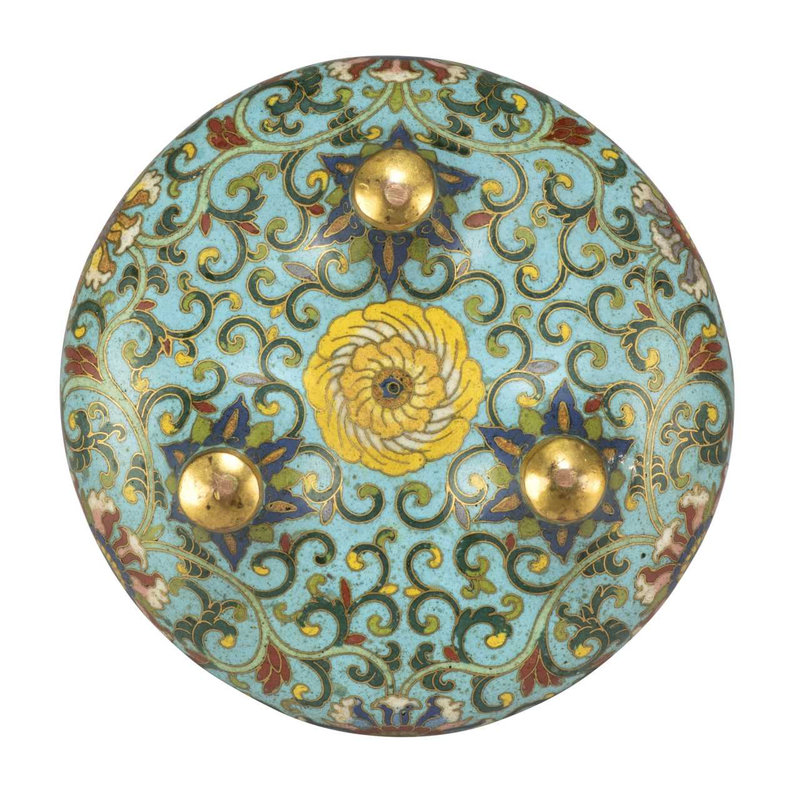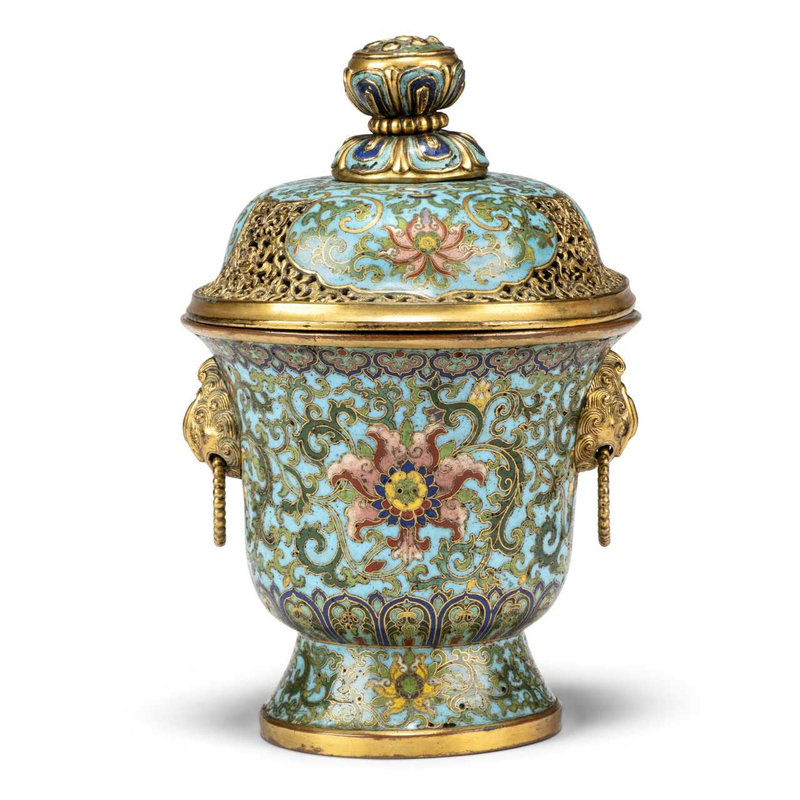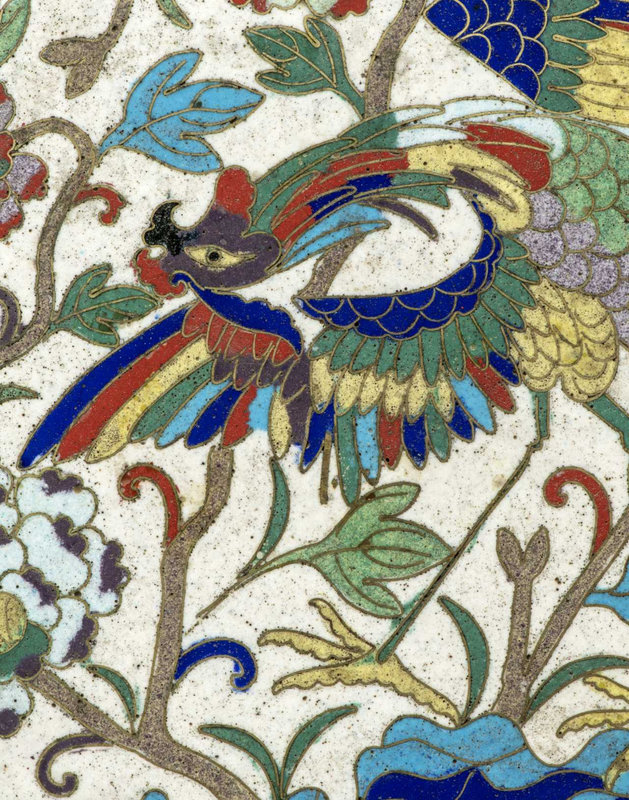Cloisonné enamels from the Schroder Collection at Christie's London, 5 July - 19 July 2022
The Schroder family came to England from Hamburg in the late eighteenth century and became amongst the most successul of Europe's merchant bankers. Johann Friedrich Schroder established a trading company in London around 1801 and was later joined by his brother, Johann Heinrich (1784-1883), who set up his own business in 1818, J. Henry Schroder & Co. Johann Heinrich was succeeded by his son, Baron Sir John Henry (1825-1910), who acquired works of art on a grand scale. He displayed his extensive collection at The Dell, an old hunting lodge on the edge of Windsor Great Park from which Christie’s sold pieces, both in 1910 over two days and the residual contents in a three-day house sale in 1979 . His collection included Chinese cloisonné enamel, Medieval and Renaissance silver, pictures, Sèvres porcelain, gold snuff boxes and Renaissance works of art and many of the pieces in this collection were undoubtedly purchased by Baron Sir John. John Henry had no children, and appointed his nephew, Baron Bruno Schroder (1867-1940), the grandfather of the late Baron Bruno Schroder (1933-2019), as his heir. Four exceptional lots of cloisonné enamels from the Schroder Collection have been offered in the Art d'Asie sale, Christie's Paris, 6 July 2022.
Lot 119. A Chinese cloisonné enamel 'lotus' baluster vase, Ming dynasty, 17th century; 95/8 in. (24.5 cm.) high. Price Realised GBP 7,560 (Estimate GBP 1,000 - GBP 2,000). © Christie's 2022
With two gilt loose-ring handles with mythical beast-head terminals, decorated with lotus blooms and scrolling foliage.
The Schroder Collection
Provenance: Acquired by Baron Sir John Henry Schröder (1825-1910) and by descent to Baron Bruno Schroder (1933-2019).
Lot 120. A Chinese cloisonné enamel 'lotus' tripod censer, Qianlong period (1736-1795); 5 3⁄8 in. (13.8 cm.) wide, across the handles. Price Realised GBP 12,600 (Estimate GBP 4,000 - GBP 6,000). © Christie's 2022
With two loop handles, decorated in bright enamels with a continuous design of six large lotus blooms and scrolling foliage on a turquoise ground, between bands of pendant ruyi heads below the mouth and upright lappets to the feet, the underside of the base centred with a yellow and white flower head.
The Schroder Collection
Provenance: Acquired by Baron Sir John Henry Schröder (1825-1910) and by descent to Baron Bruno Schroder (1933-2019).
Lot 121. A Chinese cloisonné enamel jar and cover, Qianlong period (1736-1795); 7 7⁄8 in. (20 cm.) high. Price Realised GBP 37,800 (Estimate GBP 6,000 - GBP 10,000). © Christie's 2022
Supported on a spreading foot and with twin gilt beast-head handles with loose rings, finely decorated in bright enamels with large lotus blooms on a ground of scrolling foliage between bands of pendant ruyi heads and upright lappets to the mouth rim and base, the cover similarly decorated and inset with openwork gilt-metal panels, surmounted by a lotus bud finial with seeds.
The Schroder Collection
Provenance: Acquired by Baron Sir John Henry Schröder (1825-1910) and by descent to Baron Bruno Schroder (1933-2019).
Lot 123. A large Chinese cloisonné enamel circular 'phoenix' box and cover, 18th-19th century; 12 3⁄8 in. (31.5 cm.) diameter. Price Realised GBP 2,772 (Estimate GBP 2,500 - GBP 4,000). © Christie's 2022
The cover decorated in bright enamels with a phoenix in flight amongst peonies on a white ground, the sides and base with bands of lotus heads and Buddhist emblems, the rims of the encircled with ruyi borders, the base glazed turquoise.
The Schroder Collection
Provenance: Acquired by Baron Sir John Henry Schröder (1825-1910) and by descent to Baron Bruno Schroder (1933-2019).
Lot 129. A Chinese cloisonné enamel archaistic gu-form vase, 18th century; 7 7⁄8 in. (19.9 cm.) high. Price Realised GBP 16,380 (Estimate GBP 8,000 - GBP 12,000). © Christie's 2022
Finely modelled after an archaic bronze gu-form, the neck decorated with four tall blade-shaped panels enclosing flower heads on scrolling foliage, the mid-section and base further embellished with stylised archaistic motifs divided by four gilt flanges.
The Schroder Collection
Provenance: Acquired by Baron Sir John Henry Schröder (1825-1910) and by descent to Baron Bruno Schroder (1933-2019).
Note: Two slightly taller archaistic gu vases, Kangxi mark and period (1662-1722), are illustrated by H. Brinker and A. Lutz, Chinese Cloisonné: The Pierre Uldry Collection, Zurich, 1989, no. 2243 and 224. A cloisonné enamel archaistic gu-form vase of similar height, Qianlong mark and period, sold Sotheby's, Hong Kong, 29 April 2022, lot 3685.
Lot 130. A pair of Chinese cloisonné enamel 'bird and flower' brushpots, bitong, 18th-19th century; 4 1⁄2 in. (11.7 cm.) high. Price Realised GBP 7,560 (Estimate GBP 1,500 - GBP 2,500). © Christie's 2022
Decorated in bright enamels with birds in flight amongst leafy flower sprays on a dark aubergine ground between bands of pendant ruyi heads and upright lappets, the underside of the bases glazed turquoise.
The Schroder Collection
Provenance: Acquired by Baron Sir John Henry Schröder (1825-1910) and by descent to Baron Bruno Schroder (1933-2019).
Christie's. Five Private Collections. London, 5 July - 19 July 2022

/https%3A%2F%2Fprofilepics.canalblog.com%2Fprofilepics%2F1%2F0%2F100183.jpg)
/https%3A%2F%2Fstorage.canalblog.com%2F03%2F02%2F119589%2F96711876_o.jpg)
/https%3A%2F%2Fstorage.canalblog.com%2F11%2F31%2F119589%2F94773502_o.jpg)
/https%3A%2F%2Fstorage.canalblog.com%2F20%2F83%2F119589%2F94772815_o.jpg)
/https%3A%2F%2Fstorage.canalblog.com%2F26%2F72%2F119589%2F75604929_o.jpg)
/https%3A%2F%2Fstorage.canalblog.com%2F59%2F60%2F119589%2F26458628_o.jpg)




























/http%3A%2F%2Fstorage.canalblog.com%2F21%2F96%2F119589%2F129836760_o.jpg)
/http%3A%2F%2Fstorage.canalblog.com%2F33%2F99%2F119589%2F129627838_o.jpg)
/http%3A%2F%2Fstorage.canalblog.com%2F07%2F83%2F119589%2F129627729_o.jpg)
/http%3A%2F%2Fstorage.canalblog.com%2F28%2F37%2F119589%2F129627693_o.jpg)